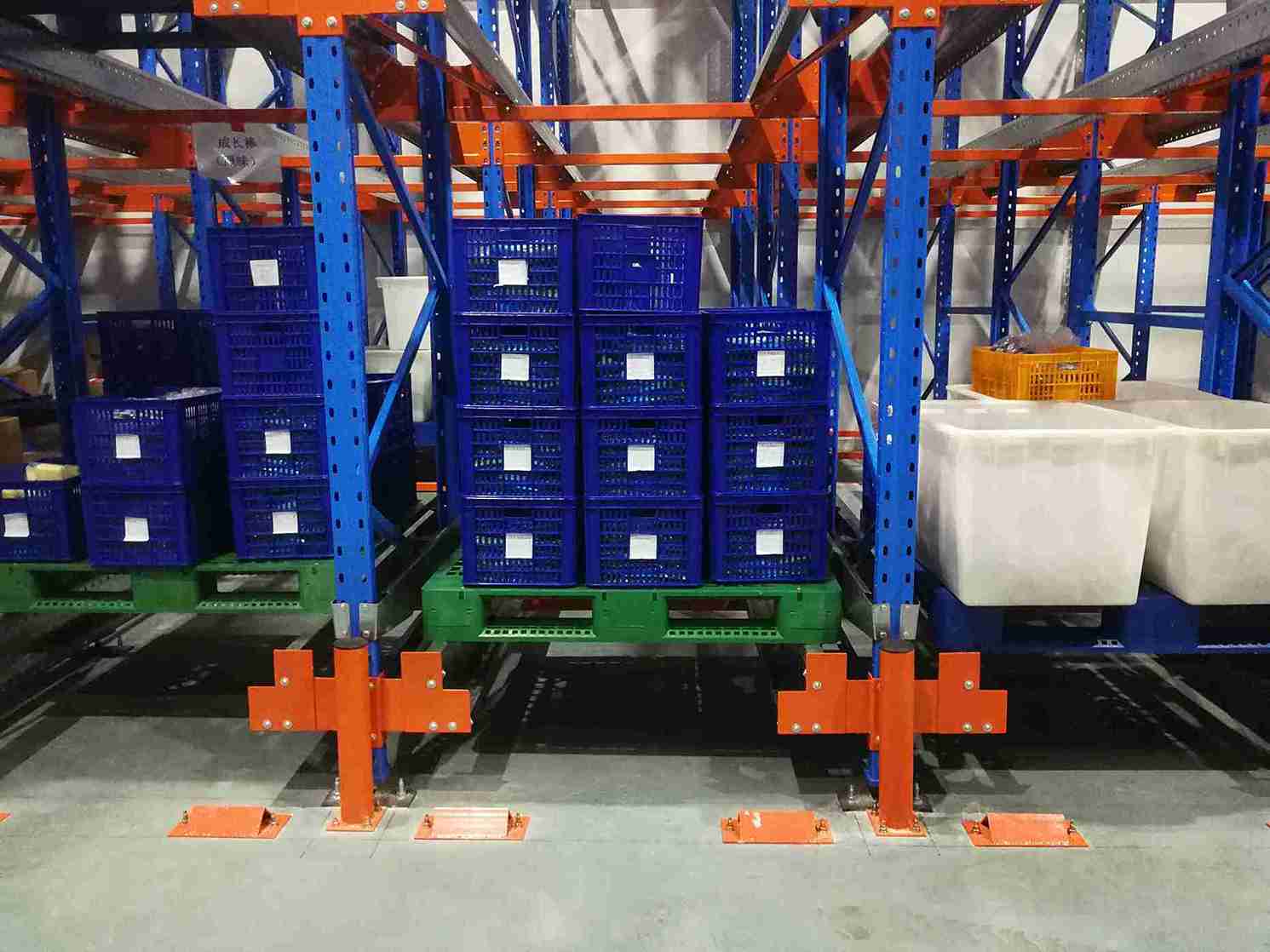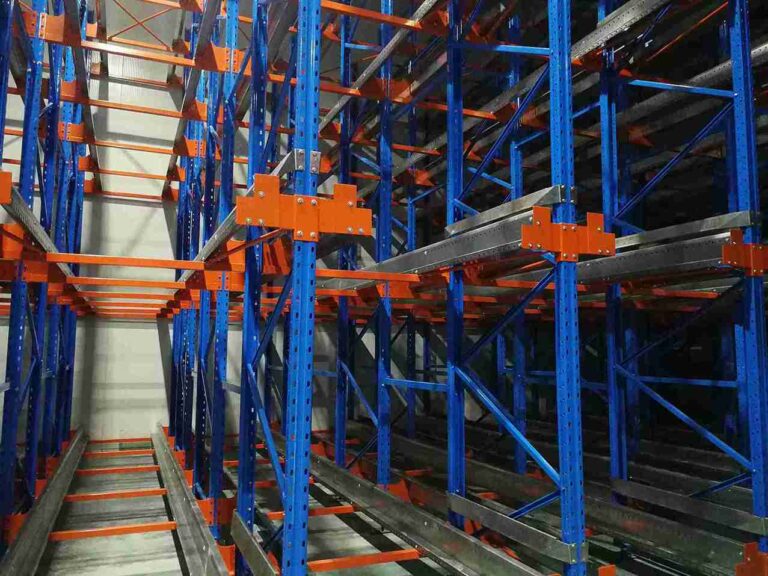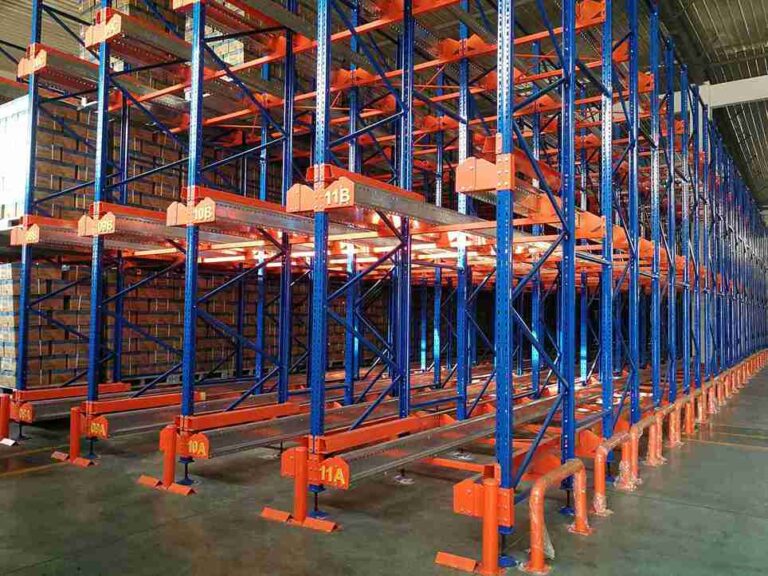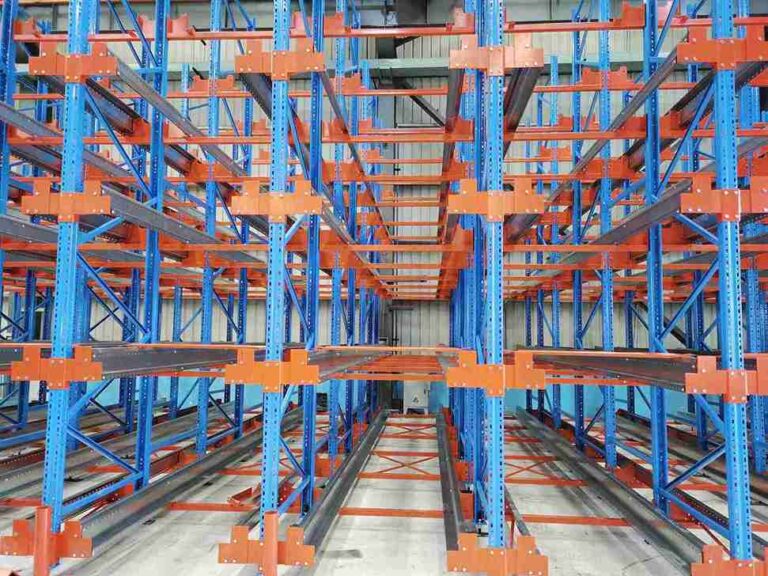📐 "First 50 Enterprise Queries Get Custom 3D Warehouse Design" Plan

In the high-stakes world of cold storage logistics, efficiency isn’t just a goal—it’s an absolute necessity. Every cubic foot of space costs a fortune to cool, every minute of manual labor in sub-zero temperatures carries risk and expense, and every instance of product damage can erase an already thin profit margin. For decades, operators have been trapped in a cycle of high energy bills, labor shortages, and preventable shrink.
But a technological revolution is changing the game: the automated shuttle rack for cold storage. This isn’t merely an equipment upgrade; it’s a comprehensive ROI-driven warehouse solution that directly attacks the biggest cost centers in a cold storage operation.
By leveraging high-density storage and semi-automation, these systems are engineered to deliver a rapid and substantial return on investment by dramatically reducing labor requirements and creating an environment that virtually eliminates product damage. This in-depth guide will dissect exactly how a shuttle rack for cold storage transforms a facility from a cost center into a model of profitability, resilience, and precision. The strategic implementation of a shuttle rack for cold storage represents the future of frozen and refrigerated logistics, offering a tangible path to operational and financial excellence.

The Cold Storage Conundrum: High Costs, Higher Risks
Running a cold storage or freezer warehouse is arguably one of the most challenging and capital-intensive endeavors in modern logistics. The very nature of the environment creates a unique set of problems that traditional storage methods struggle to address effectively. The shuttle rack for cold storage emerges as a direct response to these industry-wide pain points, offering a engineered solution to problems that have long been considered unavoidable costs of doing business.
The Immense Financial Burden of Energy Consumption
The largest ongoing expense for any cold storage operator is energy. Maintaining temperatures at -25°C (-13°F) or lower is a massive undertaking. Every time a conventional forklift enters an aisle, it brings heat with it. Every time a door is opened to access a single pallet, cold air escapes, and the refrigeration system must work overtime to recover the lost energy. Wide aisles required for forklift maneuverability represent thousands of cubic feet of wasted, yet expensively cooled, space. This inefficiency translates directly to an enormous and recurring utility bill. A well-designed shuttle rack for cold storage system attacks this problem at its root by fundamentally reconfiguring the storage layout to minimize wasted space and reduce thermal exchange.
The Labor Crisis in Harsh Environments
Finding and retaining qualified forklift operators willing to work in freezing conditions is increasingly difficult. It’s not just a matter of comfort; it’s a significant safety and financial issue. Productivity naturally drops in extreme cold, and the risk of accidents increases. High turnover rates lead to constant training costs and operational inconsistencies. The labor market is tight, and wages are rising, making manual pallet handling a volatile and expensive cost center. The automation provided by a shuttle rack for cold storage redefines the human role in the warehouse, moving operators to a more controlled environment and leveraging their skills for higher-value tasks rather than repetitive, physically demanding work in dangerous conditions.
The Silent Profit Killer: Product Damage
In a manual cold storage operation, product damage is rampant. Forklifts can easily nick, puncture, or crush pallets and their contents. In a multi-deep drive-in racking system, the potential for damage during put-away and retrieval is exceptionally high. For high-value goods like pharmaceuticals, specialty foods, or premium seafood, a single punctured package can result in hundreds or thousands of dollars in lost product and chargebacks from clients. This damage often goes unnoticed until it’s too late, directly eating into the bottom line. The precision handling of a shuttle rack for cold storage is designed to eliminate this category of loss entirely, protecting both the product and the profit margin it represents.
What is an Automated Shuttle Rack System? The Engine of Efficiency
An automated shuttle rack for cold storage is a high-density storage system that represents a paradigm shift in how frozen and refrigerated goods are stored and handled. It consists of two main components: a static racking structure and a mobile, battery-powered robotic shuttle. This combination creates a highly efficient, semi-automated environment specifically engineered for the harsh demands of a cold storage facility. The fundamental design principle of any shuttle rack for cold storage is to maximize storage density while minimizing the need for human intervention within the storage lanes themselves.
The Core Components: Rack and Robot
The racking in a shuttle rack for cold storage is typically a custom-engineered, compact structure with rails on each storage level. This is not standard pallet racking; it is a purpose-built system designed to support the weight of fully loaded pallets in a dense configuration and to guide the shuttle with precision. The real magic lies in the shuttle robot. This device is designed to travel along the rails within a single lane of racking, transporting pallets to and from the picking face.
It’s a simple yet profoundly effective piece of engineering. Operators never need to enter the racking structure itself. They simply place a pallet at the front of a lane, and the shuttle takes over, automatically transporting it to the first available position deep within the lane. The process is reversed for retrieval. The reliability of this robot is the cornerstone of an effective shuttle rack for cold storage solution.
Semi-Automation: The Perfect Balance of Tech and Control
It’s crucial to understand that most shuttle rack for cold storage systems are semi-automatic. This is a key advantage. Operators gain the immense benefits of automation—consistency, speed, and density—without the massive capital outlay and complexity of a fully automated AS/RS (Automated Storage and Retrieval System). The human operator is still in the loop, managing the shuttle via a simple wireless remote control or terminal, making strategic decisions, and handling the interface between the shuttle system and other warehouse equipment, like conveyors or forklifts at the lane entrance. This balance makes the shuttle rack for cold storage an accessible and scalable technology for many operations that are not yet ready for full lights-out automation.
The ROI Blueprint: How a Shuttle System Pays for Itself
The return on investment for a cold storage shuttle system is not a vague promise; it’s a calculable outcome derived from attacking specific, measurable costs. The financial justification for investing in a shuttle rack for cold storage is built on multiple pillars, each contributing to a stronger bottom line and a more resilient operation. Companies that conduct a thorough analysis often find that the combined savings create a compelling business case with a clearly defined payback period.
Dramatic Labor Reduction and Productivity Gains
This is often the most immediate and noticeable ROI driver for a shuttle rack for cold storage.
Fewer Operators, Higher Output: One operator can now manage the entire storage and retrieval process for multiple lanes. Instead of a forklift driver spending 10 minutes carefully maneuvering into a deep lane, they can drop a pallet at the lane entrance and immediately move to the next task. The shuttle does the slow, precise work inside the rack. This allows companies to achieve more with their existing workforce or reallocate staff to more value-added tasks, effectively increasing overall warehouse productivity without increasing headcount.
Elimination of Specialized Forklift Driving: Operating a forklift in a -25°C narrow-aisle rack is a specialized skill. With a shuttle rack for cold storage system, the requirement for pinpoint forklift precision inside the racks is eliminated. Operators can work from a more comfortable and safer zone, reducing training needs and broadening the potential labor pool. This reduces dependency on highly specialized, hard-to-find talent and associated premium wages.
Unprecedented Density: Turning Space into Profit
The single biggest source of waste in a traditional cold storage warehouse is unused air space. A shuttle rack for cold storage system recaptures this wasted asset.
Elimination of Aisles: By removing the need for forklifts to enter the racks, companies can eliminate all but one front-facing “pick-up and deposit” (P&D) aisle. This creates a high-density storage system where pallets are stored back-to-back and floor-to-ceiling. It’s not uncommon to achieve a 40-60% increase in storage capacity within the same building footprint. This density is the primary reason many facilities choose to implement a shuttle rack for cold storage.
The Real Estate Alternative: For many businesses, expanding storage capacity by building a new cold storage facility is a multi-million dollar project. A shuttle rack for cold storage system allows a company to effectively create a new warehouse within its existing four walls, deferring or eliminating the need for colossal capital expenditure on new construction. The cost of the system is often a fraction of the cost of new land and building development.
Minimizing Product Damage: Protecting Your Bottom Line
A shuttle rack for cold storage system creates a fundamentally safer environment for inventory.
No More Forklift Contact: Since forklifts never enter the storage lanes, the primary cause of impact damage is completely eliminated. Pallets are handled gently and precisely by the shuttle machine, which is designed for smooth acceleration and deceleration. This single benefit can save hundreds of thousands of dollars per year for facilities handling high-value frozen goods.
Optimal FIFO and LIFO Management: The shuttle software ensures perfect inventory rotation. Whether an operation requires First-In-First-Out (FIFO) for perishable goods or Last-In-First-Out (LIFO) for other products, the system executes the strategy flawlessly. This prevents older stock from being buried and becoming unsellable, a hidden form of product damage that plagues manual warehouses. The precision of a shuttle rack for cold storage is unmatched in this regard.
Energy Savings: A Cooler Operation
The energy savings from a shuttle rack for cold storage are twofold and significant.
Reduced Refrigeration Load: A denser storage configuration means less air volume to cool. By minimizing empty space, a company is effectively reducing the total cubic footage that its refrigeration system needs to keep cold. Furthermore, with far fewer door openings and less heat intrusion from forklift traffic, the system doesn’t have to work as hard to maintain temperature, leading to lower energy consumption. The insulation effect of dense pallet storage also contributes to thermal stability.
Smaller Footprint, Smaller Bill: If a company can achieve its storage goals in a smaller building thanks to the higher density provided by a shuttle rack for cold storage, the energy savings from lighting and cooling that smaller space are immense. For new projects, this can lead to a smaller, more efficient building design from the outset.
Quantifying the Savings: A Hypothetical Case Study
Let’s put hard numbers to these principles. Imagine a mid-sized cold storage facility facing common challenges. The decision to invest in a shuttle rack for cold storage is a strategic one, and the financial modeling behind it is critical for gaining executive approval.
Pre-Shuttle Scenario:
Facility Size: 50,000 sq. ft.
Pallet Positions: 8,000 (using selective racking)
Labor: 6 forklift operators per shift
Product Damage: 1.5% annual loss
Annual Energy Bill: $300,000
Post-Shuttle Implementation:
Pallet Positions: Increased to 12,000 (50% density increase) due to the high-density layout of the shuttle rack for cold storage.
Labor: Reduced to 4 operators per shift (managing more throughput)
Product Damage: Reduced to 0.2% annual loss due to eliminated forklift contact.
Estimated Energy Savings: 20% due to reduced air volume and less heat intrusion.
Annual Savings Calculation:
Labor Savings (2 operators @ $60k all-in cost): $120,000
Product Damage Savings (1.3% of $20M inventory): $260,000
Energy Savings (20% of $300k): $60,000
Throughput & Error Reduction: ~$50,000 (estimated)
Total Annual Savings: $490,000
With a typical system investment for a facility of this size ranging from $500,000 to $1.5M depending on size and complexity, the payback period can often be under 3 years. After that, the savings flow directly to the bottom line, making the shuttle rack for cold storage one of the most impactful investments a cold storage operator can make.
Beyond ROI: The Strategic Advantages of Shuttle Systems
The financial payback is compelling, but the strategic benefits are what provide a long-term competitive edge. A shuttle rack for cold storage does more than just save money; it transforms an operation’s capabilities, making it more agile, accurate, and reliable. These intangible benefits often prove to be just as valuable as the hard cost savings.
Enhanced Accuracy and Inventory Control
With integrated Warehouse Management System (WMS) software, every pallet movement in a shuttle rack for cold storage is tracked. Operators gain real-time, 100% accurate visibility into their inventory. No more lost pallets, no more mispicks. This level of control is invaluable for compliance in industries like pharmaceuticals and food safety (FDA, HACCP). The audit trail provided by the system’s software simplifies reporting and ensures complete traceability from receipt to shipment, a critical factor in modern supply chains.
Improved Safety and Worker Morale
The shuttle rack for cold storage system drastically improves safety. Operators work in a safer, less stressful environment, away from the extreme cold of the storage aisles. The risk of rack collisions, product drops, and physical strain is minimized. This leads to higher morale, lower absenteeism, and reduced insurance premiums. Companies that invest in the well-being of their employees through technology like a shuttle rack for cold storage often see a positive cultural shift and become employers of choice in a competitive market.
Scalability and Flexibility
A significant advantage of the shuttle rack for cold storage is its modular nature. Companies are not forced to automate the entire warehouse in one go. They can start by automating their most problematic or high-turnover product lines and gradually expand the system as their business grows. The shuttles themselves can be moved between lanes and even between facilities, providing operational flexibility that fixed automation lacks. This allows for a phased investment approach that aligns with budget and business growth plans.
Is a Shuttle System Right for Your Operation?
While powerful, a shuttle rack for cold storage system is not a one-size-fits-all solution. It is ideally suited for operations with specific characteristics. Understanding the ideal use case ensures that the technology delivers on its promise and provides maximum value.
The perfect candidate for a shuttle rack for cold storage is typically a facility with high volumes of a limited number of SKUs (High SKU depth). Operations requiring strict FIFO or LIFO inventory management are also excellent candidates, as the system excels at enforcing these disciplines. Businesses storing high-value, damage-sensitive products will find the product protection benefits to be a major justification. Warehouses facing severe labor shortages or space constraints will see immediate relief from these pressures upon implementing a shuttle rack for cold storage. Finally, companies looking for a stepping stone to full automation without the massive upfront investment find that a shuttle rack for cold storage offers the perfect middle ground.
Conclusion: The Future of Cold Storage is Automated and ROI-Ready
The economic pressures facing the cold storage industry are not going away; they are intensifying. Relying on outdated, manual storage methods is a strategic risk that exposes businesses to rising costs, operational instability, and preventable losses. The automated shuttle rack for cold storage is no longer a futuristic concept—it is a present-day, proven, and ROI-driven warehouse solution that delivers a rapid and undeniable return on investment.
It is a tangible answer to the critical challenges of labor reduction, product damage minimization, and energy efficiency. By making the strategic decision to invest in this technology, operators are not just purchasing equipment; they are fundamentally future-proofing their operation, building a more resilient, profitable, and competitive business ready to thrive in the demanding landscape of modern logistics. The shuttle rack for cold storage has firmly established itself as the industry standard for those seeking to overcome the inherent challenges of cold chain logistics and achieve a new level of operational excellence.
Frequently Asked Questions (FAQs)
1. How does the shuttle system perform in extreme freezing temperatures, say below -30°C?
Professional-grade shuttle rack for cold storage systems are specifically engineered for deep-freeze environments. They utilize cold-rated lubricants, specialized batteries designed for optimal performance in extreme cold (often with built-in heating elements), and hardened components to prevent brittle fractures. Reputable manufacturers subject their shuttle vehicles to rigorous testing in environmental chambers to ensure reliability at temperatures as low as -35°C. Always ensure the specific shuttle rack for cold storage model selected is rated for your facility’s operational temperature.
2. What happens if the shuttle robot breaks down inside a lane?
Robust shuttle rack for cold storage systems are designed with redundancy and recovery in mind. Many shuttles can be manually retrieved using simple tools without disrupting the entire lane. Furthermore, it’s a best practice to have at least one spare shuttle on hand. This allows operators to quickly swap in the spare unit to continue operations while the faulty unit is serviced, minimizing any disruption. The modularity of a typical shuttle rack for cold storage design means a single lane outage does not cripple the entire warehouse operation.
3. Can shuttle systems integrate with our existing Warehouse Management System (WMS)?
Absolutely. Modern shuttle rack for cold storage systems come with their own proprietary control software that is designed to seamlessly integrate with leading WMS platforms through APIs (Application Programming Interfaces). This bi-directional communication ensures that inventory data is updated in real-time across all systems, maintaining a single source of truth for stock levels. During the planning phase of a shuttle rack for cold storage project, integration protocols are a key discussion point to ensure a smooth flow of data.
4. We have uneven pallet sizes and weights. Is that a problem?
A proper shuttle rack for cold storage installation begins with a thorough consultation and engineering analysis. The system can be designed to handle a range of pallet sizes (e.g., EUR, CHEP, standard) and weights. The key is to group SKUs with similar pallet specifications into dedicated lanes to maintain optimal efficiency. The system’s software can be configured to know the specifications for each lane, and the shuttle itself can often be adjusted to handle different pallet dimensions. A quality shuttle rack for cold storage provider will conduct a full pallet audit before finalizing the system design.
5. What is the typical lead time from order to full operational deployment?
Lead times can vary significantly based on the global supply chain climate and the project’s complexity. Generally, for a standard shuttle rack for cold storage system, you can expect a timeline of 4-8 weeks for manufacturing and shipping, followed by 2-4 weeks for on-site installation, commissioning, and operator training. A total project timeline of 3-4 months from signed order to going live is a common benchmark. More complex projects involving significant building modification or full warehouse integration may take longer. An experienced shuttle rack for cold storage supplier will provide a detailed project plan with clear milestones.
Welcome to contact us, if you need warehouse rack CAD drawings. We can provide you with warehouse rack planning and design for free. Our email address is: jili@geelyracks.com




